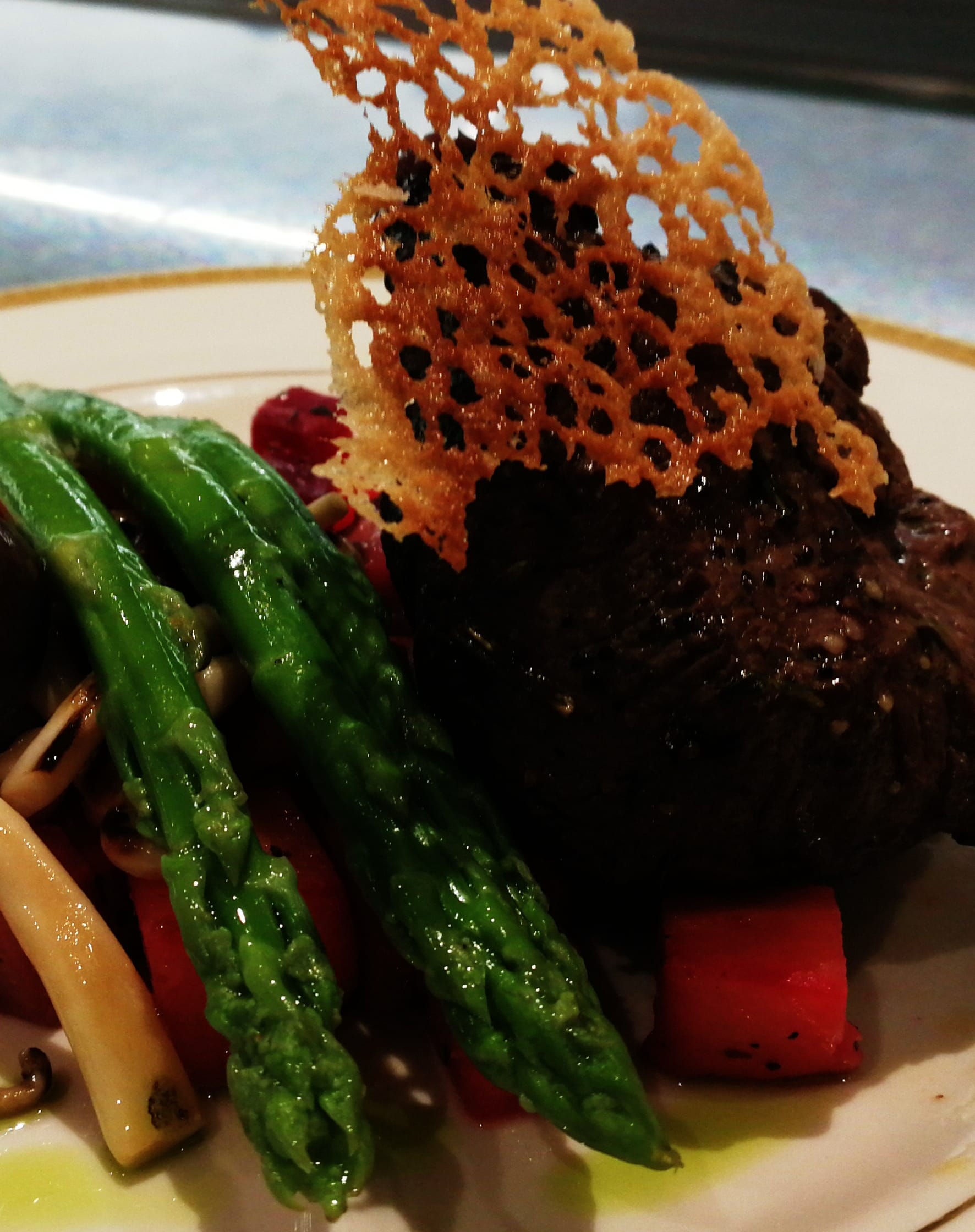One might expect that having just returned from a Cretan holiday during which I heaped accolades on our favorite meat dishes of lamb and goat, that I am still in a state of denial and remain in holiday mode, trying to keep the Cretan Island dream alive.
Not so!
Herbed frenched rack of lamb (sounds a bit like meat porn): ’tis not your usual daily fare but a main course reserved to impress diners at special dinners and banquets. The ‘frenched’ refers to French trimming or the cleaning of the rib bones from fat, gristle and sinew to give it a clean appearance. It tastes and looks fantastic and when served up with a side of steamed asparagus spears and brunoised roasted root vegetables and thyme, it’s in a class of its own.
But!!!
Just when you think you have everything sorted, the partner of one of the important guests decides that she can’t stomach another “lamb chop” and prefers beef. That’s the way it goes in this business: we are here to please.
Beef filet mignon is one of the most tender and lean cuts of beef. In French it literally means the fine fillet. The medallion of filet mignon is presented as a round cut taken from the thinner end of a piece of tenderloin beef. The tenderloin cut runs along both sides of the spine of the beast.
Because of the low-fat content of the tenderloin, filet mignon has a mild flavour and is usually served up with a sauce or garnish of some kind to add to the festivities.
Filet mignon in shallot and red wine sauce
Filet mignon
Ingredients
- Either purchase from your butcher pre-cut medallions of filet mignon (approx 200 grams each) or purchase a 1 to 1.5 kg piece of beef tenderloin and cut the medallions yourself.
- 2 sprigs of fresh rosemary
- 1 small bunch of fresh thyme
- Coarse freshly ground black pepper
- Coarse Atlantic sea salt
- Shluk of canola oil
Method
Remove the medallions of filet mignon from the fridge, cover and leave to sit at room temperature for an hour before cooking. Make sure they are out of the way of pets. Just before starting, sprinkle coarse salt and ground black pepper ensuring all sides of the medallion are nicely salted and peppered.
Place rosemary and thyme in a pan with a shluk of canola oil, heat to medium-high temperature, add the medallions and start browning all sides. Be careful the meat doesn’t burn. Move the rosemary and thyme around the pan, ensuring each medallion gets a good rub. Once nice and brown, place on a paper-lined oven tray. This method of pre-browning the meat allows you to prepare earlier and finish in the oven later. If you return the browned meat to fridge, remove it 45 minutes to an hour before the final cooking.
Place the tray and meat in an oven preheated to 190° Celsius. A probe thermometer is useful as it allows you to cook by temperature inside the meat; if using a thermometer, cook the meat to 55-57° C for medium rare. If you have no thermometer, then 11-12 minutes should be enough. Remove from oven, place on a cutting board and cover with an aluminum foil tent for six to eight minutes before plating and serving. While the meat rests, finish the vegetables and steam the asparagus.
Spoon a little warm shallot and red wine sauce over each medallion before serving.
Shallot and red wine sauce (from BBC Goodfood.com; Gordon Ramsay recipe)
Ingredients
- 250 g shallots, peeled and finely diced
- 4 tablespoons olive oil
- 1 sprig of rosemary washed and dried
- 1 large clove of garlic
- 5 tablespoons balsamic vinegar
- 400 ml red wine
- 400 ml chicken stock
- Knob of butter or margarine
- Coarsely ground black pepper
- Salt
Method
Put olive oil into a small pot on a high heat, add shallots and stir frequently for several minutes until lightly browned. Add a good pinch of black pepper, rosemary and a crushed garlic clove. Keep stirring on a high heat to stop the onions burning, add the balsamic vinegar and cook down briefly, allowing the liquid to reduce to a syrup. Add the red wine, reduce heat to medium and reduce by two thirds. Add chicken stock, bring to a boil and reduce heat to low and simmer until reduced by two thirds, again. Add a little salt, then stir in the knob of butter or margarine, ready to spoon over the filet mignon before serving.
This one has to be a good and posh feed: a five-star recommendation from me.


If you enjoyed this recipe why not share it with your friends via social media or e-mail? If you want a copy of your own select the print option at the top of the page.






